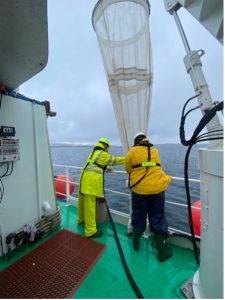Hey there! I’m Hanna Sannes, and I’ve recently embarked on an exhilarating journey with the Cnidaria and Ctenophora research team at the University Museum of Bergen. This semester, I’ve been engrossed in a project called Pole2Pole, and it’s been nothing short of amazing. As I share tales from my adventures with the Cnidaria and Ctenophora research team, I’ve cheekily dubbed myself an ‘expert’ in the field. But let’s be clear – this title comes with a wink and a nudge. While I’ve learned to navigate both the rolling waves of the ocean and the swirling eddies of genetic data, I’m still far from being a seasoned pro. Each day brings its surprises and ‘aha!’ moments, reminding me that I’m still dipping my toes in the shallow end of the vast ocean of knowledge. So, join me as I recount my escapades with these gelatinous marvels, where every success is celebrated, every mistake is a lesson, and ‘expertise’ is just another word for ‘enthusiastic learner’.
Diving headfirst into the field, I’ve had the incredible chance to participate in field sampling, where I’ve encountered an array of stunning jellyfish – species I never even knew existed! I’ve honed the art of distinguishing these ethereal beings, a skill that’s as unexpected as fascinating. Aboard the Hans Brattström, I helped collect fresh plankton samples, wrestling with the WP3 plankton net (which was, luckily, easier than expected). We also collected water samples using a CTD (conductivity, temperature, and depth) instrument. On our final sampling day, we collected eDNA (environmental DNA) in the water. This is used to compare with the fresh samples we get.
From the left: Handling the WP3 plankton net, collecting water samples with CTD, and filtering eDNA from water samples.
Back at the morphology lab, we delved into the samples collected from our field trip. Amidst the organized chaos, we identified and tallied the jellies, species by species. One day, I counted a whopping 300 Chaetognaths!
From the left: Chaetognatha, Euphysa aurata and Bougainvillia muscoides, the largest are Lensia conoidea anterior nectophore, some are Eudoxia of Dymophyes arctica and 1 nectophore of Nanomia care (and other types of plankton).
And the adventure didn’t stop at fieldwork! Inside the DNA lab’s high-tech realm, I got my hands on the molecular biology methods that were once just parts of textbooks and lectures. It was finally my turn to take the reins: extracting DNA from our gelatinous friends, firing up the thermocycler for some PCR action, running the gel electrophoresis to spy on the elusive DNA strands and purifying the successful DNA samples before sending them to the sequencing lab.
From the left: Preparing the samples for PCR, finished gel electrophoresis, and looking at the results from gel electrophoresis (hoping that the bands are DNA from jellyfish).
The defining moment came not only from observing bands on the gel but also from what happened after sequencing when the samples were transformed into chromatograms ready for BLAST analysis. That was when I would find out if the DNA sequences truly belonged to our jellyfish or if they somehow reflected my DNA or another organism’s DNA.
From the left: DNA sequence of a specimen of Pyrostephos vanhoeffni (photographed to the right, photo credit: Joan J. Soto-Angel), 16S ribosomal RNA gene.
I owe a hefty dose of gratitude to the Cnidaria and Ctenophora research group. Their warmth and guidance were like a beacon as I navigated this sea of knowledge. I was embraced as one of their own and not just a visitor, which meant a lot throughout this project. Lilly, my fellow BIO299 mate, and I also got to join a conference at the University Museum of Bergen. It was a sneak peek into the researcher’s life – complete with the buzz of biosystematics and a mosaic of expert voices. Throughout this journey, I have discovered new facts about jellyfish (and their unexpected parasitic companions) and so much more! This is all thanks to my great supervisors, Joan J. Soto-Angel and Luis Martell.
To anyone questioning doing BIO299, here’s my two cents: Go for it! Yes, it’s a whirlwind – demanding, intense, but oh so enriching. You’ll emerge with a treasure trove of skills, insights, and perhaps, like me, a clearer vision of your future in biology.










